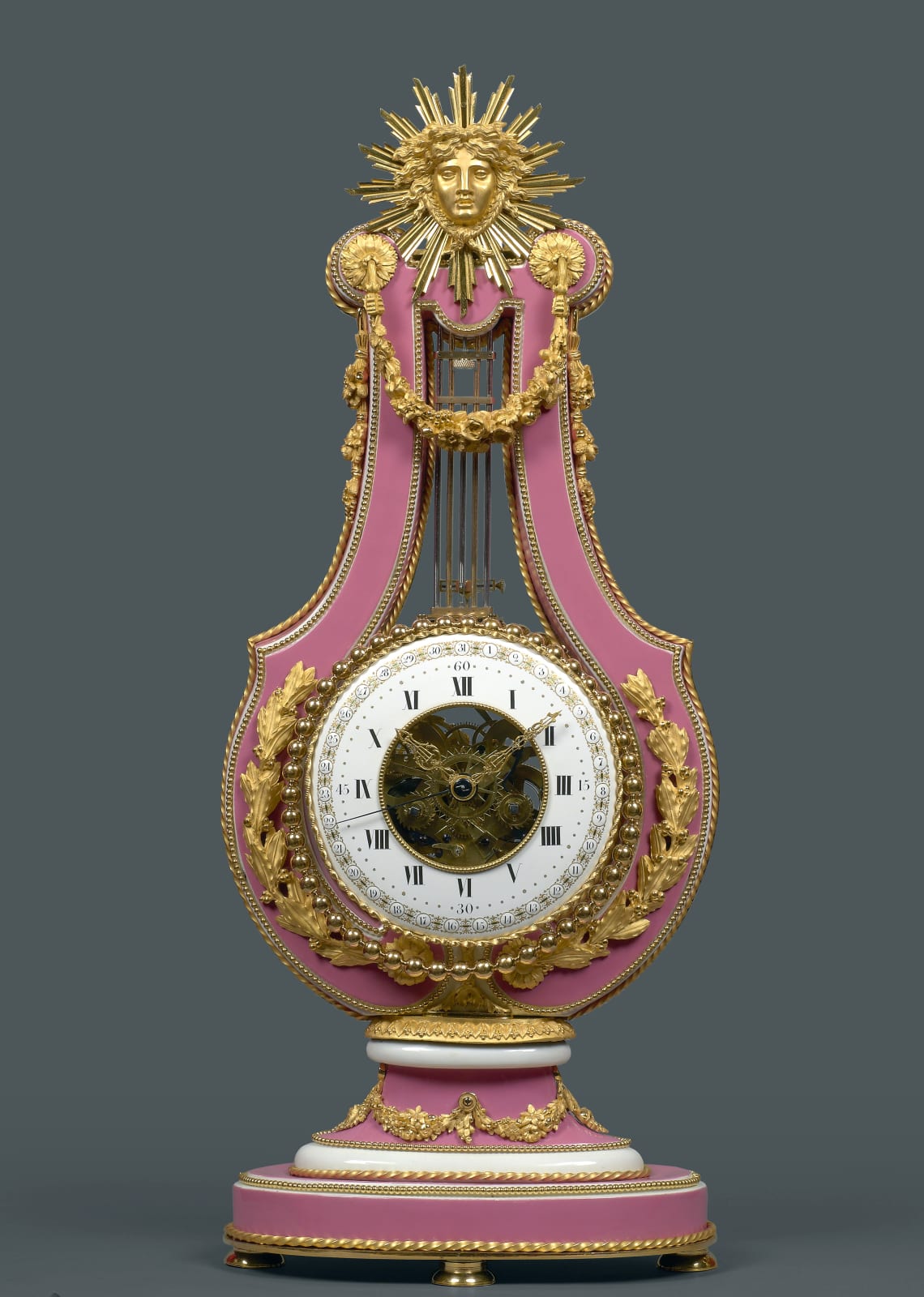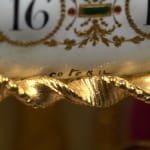Joseph Coteau French, 1740-1812
Further images
Literature
Cedric Jagger, "Royal Clocks", 1983, p. 130, pl. 176, illustrating a very similar Sèvres lyre clock of beau bleu enamel, movement by Kinable and dial by Dubuisson; and p. 131, pl. 178, illustrating another almost identical clock with movement by Jean-Antoine Garrigues, both in the British Royal Collection. Pierre Verlet, "Les Bronzes Dorés Français du XVIIIe Siècle", 1987, p. 41, illustrating a Sèvres beau bleu lyre clock of 1787 with enamel work by Joseph Coteau, originally at Versailles and now in the Musée du Louvre. Tardy, "Les Plus Belles Pendules Françaises", 1994, p. 80, illustrating a very similar Sèvres lyre clock with dial by Coteau and p. 81, illustrating a very similar Sèvres lyre clock with mounts by Duplessis, movement by Kinable and dial by Coteau in the Victoria and Albert Museum, London. Jean-Dominique Augarde, "Les Ouvriers du Temps", 1996, p. 258, pl. 203, illustrating a very similar beau bleu Sèvres lyre clock with movement by Garrigues and dial attributed to Coteau probably made for the duc d'Orléans. Pierre Kjellberg, "Encyclopédie de la Pendule Française du Moyen Age au XXe Siècle", 1997, p. 230, pl. A, illustrating a similar bleu turquoise Sèvres porcelain lyre clock with movement by Kinable and pl. B, illustrating another very similar beau bleu Sèvres lyre clock with movement by Garrigues and dial by Coteau, in the Musée de Sèvres. Elke Niehüser, "Die Französische Bronzeuhr", 1997, p. 261, pls. 1256-1259, illustrating variations of the present model.
A rare and important Louis XVI gilt bronze mounted Sèvres rose pink porcelain skeletonised lyre clock with extremely fine enamel work by Joseph Coteau and movement attributed to Dieudonné Kinable, signed Coteau on the white enamel below 6 o'clock, the dial with inner Roman numerals for the hours and Arabic numerals 15/30/45 and 60 for the minutes, with an outer calendar ring for the 31 days in the month, each numeral within a circular gilt beaded frame interspersed by exquisite polychrome painted foliate decorations with delicately jewelled designs, with a very fine pair of pierced gilt brass hands for the hours and minutes and a blued steel pointer for the calendar indications. The dial with a cut-out centre to reveal the skeletonised pinwheel movement with anchor escapement, striking on the half hour on a single bell. The beautiful lyre-shaped case with beaded gilt bronze borders and an applied gilded laurel wreath, surmounted by a fine gilt bronze Apollo mask within a sunburst above a pair of rosettes from which suspend fruiting swags, with a five rod gridiron pendulum with a free-swinging gilt beaded and paste brilliants ring surrounding the dial, on a stepped elliptical pedestal hung with floral garlands and mounted with rope-twist and beaded borders on bun feet
Paris, date circa 1795-97
Height 61 cm, width 25 cm, depth 15 cm.
JOSEPH COTEAU (1740-1812)
Painted enamel and porcelain dials became increasingly popular during the reign of Louis XVI, reaching perfection in the hands of Joseph Coteau and Gobin Etienne (known as Dubuisson). Coteau was born in Geneva, Switzerland but is known to have practised his specialised craft in Paris. During his maturity he was established at Rue Toupee in the parish of Sant-Andre-des-Arts, where he remained until his death. At the age of 23 he produced the dial for a musical clock by Daille, horologer to Madame la Dauphine, 1763(Wallace Collection, London). Coteau attained such repute that he only ever supplied to the most eminent horologists, including Antide Janvier (1751-1835), Robert Robin (1742-1809) and Ferdinand Berthoud (1727-1807). He is also known to have decorated pieces of jewellery.
Coteau clock dials have a characteristic style, due as much to their superior quality as to their subject. His most distinct decoration consisted of delicate numerals with small garlands of flowers but more usually with signs of the zodiac, each element worked as an individual miniature. Other dials had little or no extra ornament except for the classical Louis XVI style numerals, such as his dial for the Avignon Clock, 1771 (Wallace Collection, London), with the movement by Delunesy and elaborate gilt bronze case sculptured by Louis-Simon Boizot (1743-1809) and executed by Pierre Gouthiere (1732-C.1812). At other times Coteau supplied decorative bands to accompany clock cases, such as an enamel frieze around a vase adorning one of Robert Robin's elaborate clocks, c.1780 (Wallace Collection, London). The band, painted in grisaille, depicts the seasons personified by infants playing and is interspersed by four cameo heads. A similar clock was supplied to Marie Antoinette for Chateau St. Cloud. Decorative dials and their accompanying complex quality movements fell in demand during the Revolution, however Coteau was patronised by the new government to create a number of Republican ten hour dials.
It appears that Coteau never enamelled watches or small scale pieces but specialised in larger works, which were technically more complex due to shrinkage during firing. The techniques required a high degree of skill to achieve a perfect finish. Coteau experimented with various polychromes, producing a blue that was so rare and complex that few if any of his contemporaries managed to copy. The enamel paint was applied with a brush onto a copper plate and the various colours vitrified one by one in a muffle kiln. The decoration was then enhanced by delicate gilding, which after firing resulted in a matt finish, the gilding was finally burnished to restore its metallic brightness.
Coteau dials are extremly rare, they are sometimes "secretly" inscribed on the reverse, in either pen or bruch. In addition to their scarcity and their supreme quality, his dials and enamel plaques only accompanied the most complex quality mechanisms. For these reasons his work is a tru prize and significantly enhances the value of any clock. Examples of his work can be found in a number of European museums, including Mobilier National, Musee des Arts Decoratifs, Paris; Carnavelet Museum, Dijon Museum, and in London at the Wallace Collection and Victoria and Albert Museum.
Copyright by Richard Redding , Zurich, all rights reserved.







